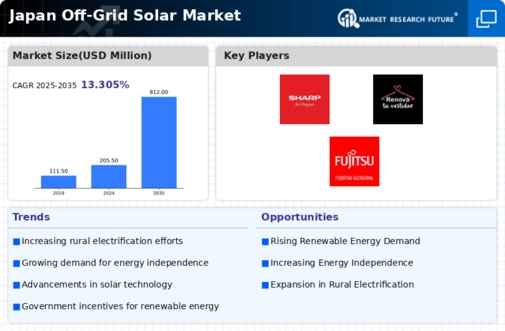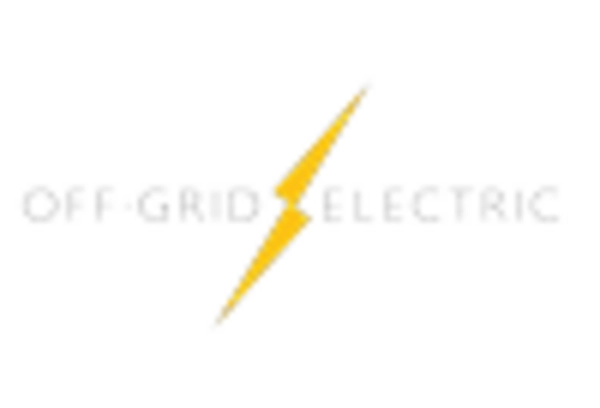The off grid-solar market in Japan is characterized by a dynamic competitive landscape, driven by increasing demand for sustainable energy solutions and technological advancements. Key players such as Sunnova Energy International Inc (US), d.light design (US), and BBOXX (GB) are actively shaping the market through innovative strategies and operational focuses. Sunnova Energy International Inc (US) emphasizes partnerships with local firms to enhance its service offerings, while d.light design (US) focuses on expanding its product range to cater to diverse consumer needs. BBOXX (GB) is leveraging digital platforms to optimize customer engagement and streamline operations, collectively contributing to a competitive environment that prioritizes innovation and customer-centric solutions.
In terms of business tactics, companies are increasingly localizing manufacturing and optimizing supply chains to enhance efficiency and reduce costs. The market structure appears moderately fragmented, with several players vying for market share. This fragmentation allows for a variety of approaches, as companies adapt to local market conditions and consumer preferences, thereby influencing the overall competitive dynamics.
In October 2025, BBOXX (GB) announced a strategic partnership with a Japanese technology firm to develop advanced solar energy storage solutions. This collaboration is expected to enhance BBOXX's product offerings and improve energy reliability for off-grid consumers in Japan. The strategic importance of this partnership lies in its potential to address the growing demand for efficient energy storage, a critical component for off-grid solar systems.
In September 2025, d.light design (US) launched a new line of solar home systems specifically designed for the Japanese market, featuring enhanced energy efficiency and user-friendly interfaces. This move signifies d.light's commitment to tailoring its products to meet local consumer needs, thereby strengthening its market position. The introduction of these systems is likely to attract a broader customer base, enhancing d.light's competitive edge.
In August 2025, Sunnova Energy International Inc (US) expanded its operations in Japan by establishing a new regional office aimed at improving customer service and support. This strategic expansion reflects Sunnova's intent to deepen its market penetration and enhance customer engagement. By localizing its operations, Sunnova is poised to respond more effectively to market demands and foster stronger relationships with consumers.
As of November 2025, current competitive trends in the off grid-solar market include a pronounced focus on digitalization, sustainability, and the integration of AI technologies. Strategic alliances are increasingly shaping the landscape, enabling companies to pool resources and expertise to drive innovation. Looking ahead, competitive differentiation is likely to evolve, shifting from price-based competition to a focus on technological advancements, innovative solutions, and supply chain reliability. This transition underscores the importance of adaptability and forward-thinking strategies in navigating the complexities of the off grid-solar market.

















Leave a Comment